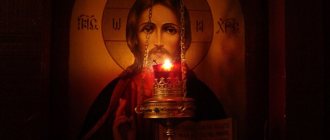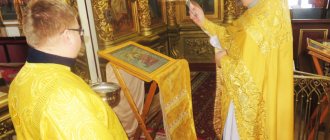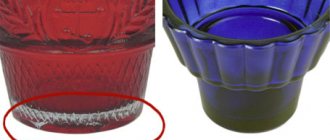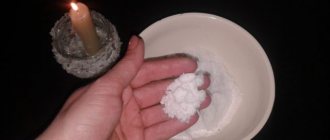A church lamp is considered one of the main symbols of a person’s unquenchable faith in God.
In ancient times, Christians illuminated dark caves with it, where local residents gathered to perform Divine services. There they hid from possible attacks from enemies and pursuers.
Later, lamps began to be used as decoration for churches and temples, as well as for various church sacraments.
In simple words, a lamp is a modified candle, the flame of which does not go out for a long time. Depending on the dimensions, methods of use and application, there are several types of lamps:
- table and wall;
- hanging - found only in churches and temples;
- extinguishable;
- inextinguishable (with continuous burning) - located near icons, relics of saints, revered shrines;
- for church processions - short candles of wide diameter are used, inserted into an oblong vessel, which promotes long and even burning;
- for home use.
The main components of the lamp are a paraffin reservoir, a stand of any shape, and a colored crystal glass on it. Red is used for Easter, blue or colorless is used during Lent, green is used daily.
How to make a lamp
The lamp is a Christian symbol of divine light that warms the souls of people. Usually it is hung in front of the iconostasis at home or in a church. But such a hand-made lamp can also be used for household or decorative purposes. It may come in handy if the electricity suddenly goes out. Or it can become the central element of the design of a summer gazebo on the site of a country house.
As a vessel that will serve as an oil reservoir, you can use a small beautiful tin jar for cookies or sweets. If you don’t have one on hand, then go to a kitchenware store. As a rule, there is a large assortment of tins and jars of various sizes and the most delightful colors.
A lamp can serve not only as an attribute of religious rituals, but also as a magnificent interior decoration.
The next step after choosing a jar is to make a wick holder:
- take a not very stiff wire of sufficient length and the core of a regular ballpoint pen;
- place the rod in the middle of the wire (like a cross);
- wind the wire around the rod in a spiral so that the turns are tightly adjacent to each other, and the total length of the turns on the rod is about 1 cm;
- remove the rod and place the wick holder on the jar: lying strictly in the center of the jar opening, it should protrude slightly beyond its limits (0.5 cm on each side);
- on the side surfaces of the jar, where the holder will be attached, make small holes with an awl;
- insert the holder into the pierced holes and bend the protruding ends of the wire.
That's it, the base of the lamp is ready.
How to make a wick for a lamp
A homemade wick can be made from an ordinary medical bandage. Take a narrow bandage and cut it to the required length. Let's cut this piece in half lengthwise. We tie the resulting ribbons on one side with a small knot. Then twist the strips of bandage tightly and tie at the end. Carefully, using a thin wire, thread the wick into the spiral of the holder (from bottom to top). Having pulled out the wick 2 cm, cut off the top knot.
After making a lamp, fill it with oil. You can use a special lamp or plant, for example, sunflower. The lamp is a source of fire hazard, be careful!
Enjoy the warmth of a living fire and be happy!
In the homes of Orthodox Christians, it is customary to hang or place lamps on a stand in front of icons. This is an ancient pious tradition that symbolizes the constant prayer of Christians to God. If there is no lamp in the house, then this house is, as it were, spiritually blind, dark, and the Name of God is not always glorified here. There can be either one lamp or more in the house. There is a pious tradition of lighting unquenchable lamps in houses, which burn both at night and when the owners are not at home. But in modern conditions this is not always possible or desirable, as it can become a temptation for non-believers or family members of little faith. Most often, a Christian lights a lamp when he comes home and does not turn it off until he leaves home. If there are no lamps, church candles are lit during prayer. Modern ascetics say that a lit lamp cleanses the air of all filth and then grace reigns in the house. In no case should you use the fire from a lamp for domestic purposes - this is disrespectful to the shrine. It is not customary to light a lamp from a match or lighter; a church candle is used for this (since the church candle is consecrated; it is recommended that this candle be deified with the blessed fire from the Holy Sepulcher). They used to say about irreverent monks in monasteries: “He lights a lamp with a match...” Lamp oil (originally olive oil), as well as a wick, can be bought in a church shop or in an Orthodox store. You can make a wick yourself from a bandage or other rag: a narrow strip of thin material is tightly twisted into a rope and pulled through the float of the lamp. The lamps come in different colors - red, blue, green, yellow. There is a tradition to light darker-colored lamps (blue) during Lent, and on holidays, throughout the Easter holiday - red, on the holiday of Trinity and Palm Sunday - green. Yellow or gold is an everyday color and is worn on ordinary days. The hanging lamp is attached to the ceiling or to the icon case. It is customary to hang it near the most revered icons. There is a pious tradition in case of illness or unfavorable circumstances to anoint children and loved ones with oil from the lamp in a cross shape. This is what St. Seraphim of Sarov did, anointing everyone who came to him with oil from the lamp. The lamp light does not need to burn very strongly and smoke; it is enough for it to be the size of one or two match heads. Children should be taught to light a lamp. There is a special prayer read when the lamp is lit: “Light up, Lord, the extinguished lamp of my soul with the light of virtue and enlighten me, Your creation, Creator and Benefactor, for You are the immaterial Light of the world, accept this material offering: light and fire, and reward me inner light to the mind and fire to the heart. Amen".
In the Christian faith, many objects carry great meaning. The lamp is no exception. This is a symbol of a person’s unquenchable faith in God. In addition, a lamp burning in a house in front of the icons means that a guardian angel is protecting this house and is in place. Living fire has entered the lives of believers so tightly that it is difficult to imagine a church without the flickering flame of candles and lamps.
When should the lamp be lit in the house? How to light a lamp correctly - Russian shrines
In the homes of Orthodox Christians there are always lamps. They are placed next to especially revered icons. It is believed that the fire of the lamp cleanses the air from every abomination. Those who have such a possibility work hard to keep the lamps burning continuously. But modern data does not always allow this.
There are not so many families where someone could always be at home. Consequently, in most cases, people light lamps when they return home and extinguish them when they leave.
Even in such a sacred matter, you need to follow basic fire safety rules; on the contrary, holy fire can begin to behave like an ordinary one, and then trouble cannot be avoided.
You will need
- - Lamp.
- - Lamp oil.
- - Church candle.
- – Matches or lighter.
- – Gauze or cotton cloth.
Instructions
1.
You can purchase lamp oil and wick in a special church store or in a shop at the temple. If there are none in the neighborhood, then you can make the wick yourself. Cut a piece of bandage or other cotton fabric. Twist it tightly into a bundle and insert it into the float of the lamp. Instead of special lamp oil, you can use olive oil.
2.
Now some believers light lamps from whatever they have at hand.
But previously it was believed that it was impossible to light a lamp easily with a match, but that one must strictly use a church candle, which is invariably present in an Orthodox home.
You can purchase candles in the same church store. A candle can be lit either from a match or from a lighter. Do this and say the Lord's Prayer.
3.
a lamp
from the candle . For this occasion there is a special prayer: “Light up, Lord, the extinguished lamp of my soul with the light of virtue and enlighten me, Your creation, Creator and Benefactor, for You are the immaterial Light of the world, accept this material offering: light and fire, and reward me with inner light mind and fire to the heart. Amen".
4.
Make sure that the fire of the lamp is not too huge. The lamp, in any case, should not smoke. A light slightly larger than a match head will be enough.
If you have several lamps in your house, light them one by one from the same church candle with the appropriate prayer. It is allowed to light lamps of different colors on different days.
Dark lamps are prepared for fasting, but on holiday you need to light a red one.
The situation is like in a normal overseas action movie of the mid-eighties - a sharp commando is thrown into impenetrable green spaces, dusk is gathering, cruel monsters have crawled out of holes, and in order to escape, it is necessary to light a fire, but as luck would have it, everything that gives away the fire is lost. There is only one match left. As a result, the morning did not come for him, because he failed to light this very match
. What to do, uncreative mentality. And so that this does not happen to anyone, we read and remember how it is allowed to light it.
Types of lamps
Lamps can be tabletop or hanging. Both require lamp pads. A table lamp can stand flat on a shelf without a lamp support, but there have been cases when, due to overheating, the lamp cracked and the oil spread. The exception is ceramic lamps. They are more reliable and usually come with a “leg”.
A hanging lamp requires a holder bracket. It is attached to the ceiling or iconostasis. This work should be carried out by a master so that the burning lamp does not fall.
It is believed that a lamp made of colored glass is better than one made of painted glass. The paint on a painted lamp may come off over time. Colored glass is not so easy to distinguish from painted glass. Usually, if you look through the edges of a lamp, the edges of a painted lamp are transparent, while those of colored glass are the same color as the lamp itself. - made of colored glass.
It can be seen that the red lamp on the left has an unpainted edge. This is paint. But the purple lamp on the right is made of colored glass.
Usually, on fasting days, a dark-colored lamp is lit - blue or green, and on holidays - a red one.
Source: https://speccypro.ru/kogda-dolzhna-goret-lampada-v-dome-kak-pravilno-zazhigat.html
Story
The first lamps are primarily lamps. The word itself is of Greek origin. The literal translation is “a lamp burning before the saints.” Initially, they were actually used for lighting in dark caves by the first Christians. There they held their services, hiding from possible pursuers.
Gradually, lamps became the most important detail of the decoration of the temple and an attribute of some church rituals. The premises of almost any church are quite light during the day, but it is impossible to find a building without burning candles or lamps. This evokes in the souls of believers a certain mood for communication with the Almighty. It doesn’t matter for what purpose you visit the temple: to pray for health or peace of soul, to repent or to thank God. Anyone who enters here will definitely light a candle, a symbol of faith in God.
Why can't you light a candle from another candle in church?
The custom of lighting lamps during prayer existed back in the days of the Old Testament. During divine services, the first Christians also used candles not only to illuminate the catacombs where they were hiding from the pagans, but also as a sign that Christ is the light of the world.
Old Believers light lamps and candles in front of images not only in the temple, but also at home. In an Old Believer church you will not find a chandelier with electric light bulbs - only candles or lamps burn on it. There are also churches in which there is no electric lighting at all.
Chandelier in the Old Believer Church
Meaning
There are no random things in churches; every object carries its own meaning. The light of a candle in a bronze candlestick or lamp is a unique symbol of prayer. In household use, a burning lamp is seen as the presence of God's Law in the house.
The lamp, located directly in front of the icons, is nothing more than an expression of sincere gratitude to the saints for their sacrifice. They gave their lives to save and forgive the sins of others.
You can often see burning lights in a cemetery. They are usually lit on the first, third, ninth and fortieth day after the funeral. This is a kind of request for mercy and forgiveness of the sins of the deceased before God. Many people bring lamps when they visit their loved ones in this place of sorrow.
Device
Essentially, a lamp is an improved candle. One option is a container with paraffin, usually a glass (crystal) cup, on a stand. Reusable use is ensured by simple replacement of flammable material. This is typical for desktop products. The stand is metal with a border and figured legs, often decorated with faith. Replaceable cups, different colors:
- red - for Easter time;
- green - for daily use;
- blue, purple or colorless - for Lent.
Supplied with wicks. They can be of different designs:
- A thin plate with a small hole in the middle for a wick. It is placed on the surface of the oil, one end of the wick is above the plate (the length of no more than one or two match heads), the second is lowered into the oil.
- The Greek design is a cork float with a solid wick stuck through it.
The operating principle is the same. The design provides the most comfortable conditions for long-lasting flame maintenance. Wide short candles are used in lamps for religious processions. They are inserted into an oblong-shaped vessel, closed on top with a tin lid with holes. This shape allows the flame to burn long and evenly.
Kinds
Products can be divided into several types. It depends on the size, place of use and location:
- hanging or church lamps are used exclusively in temples or churches;
- wall;
- desktop;
- extinguishable;
- inextinguishable - placed in front of icons, relics of saints, any especially revered shrine, they must maintain continuous combustion;
- for a religious procession;
- for household use.
The size depends on the volume of oil that can be poured into the lamp. Large ones are considered to be those with a volume of 100 to 500 milliliters. These usually illuminate icons in temples or churches. At home, small ones with a volume of 30-50 ml have proven themselves to be excellent.
A hanging lamp is not used in everyday life; it is more of a ritual object that plays an important role in the Orthodox faith. It is used at baptisms, burials, weddings, processions. Made from brass, copper, cupronickel, silver.
There are large chandeliers. They represent a massive church chandelier with many lit lamps and candles. It is customary to light them on holidays. The chandelier is located in the center of the building and looks very solemn. Often decorated with crystal pendants in which the reflections of candles are refracted. Some specimens can be compared to a work of art.
Combustion is an art
It is the pious custom of Orthodox Christians to light lamps in front of the faces of saints upon arriving home and extinguish them only when leaving the house. Lighting lamps is an art. The oil for the lamp needs special, “wooden” (olive) oil, specially purified - so that the wick burns evenly and does not go out, it is usually bought in a church shop, and wicks are also purchased there.
They light a lamp with a special prayer, but in no case should you use a match or lighter. First, you should light a special church candle, and only then light a lamp from it. The wick is screwed in such a way that it does not go out or smoke, and the oil lasts for a long time.
In Orthodox churches, red lamps are used during holidays, green lamps on weekdays, and purple lamps during Lent. Lamps come in different types: hanging, table, wall, large and small, for home prayer and for religious processions. If an Orthodox Christian does not have a lamp at home, then during prayer it can be replaced with a lit church candle.
Source
Oil
Real oil for lamps is wood. This is the name given to a product obtained from the fruits of olives growing on a tree, and not from herbs or seeds. Spruce is considered the purest and highest quality oil of the highest grade. When burning, it does not form soot and does not emit any harmful substances.
Due to its purity and healing properties, oil is used both for anointing the sick and in baptismal rites. Throughout the thousand-year history of Christianity, olive oil was considered a worthy sacrifice to God.
Why do they light a lamp?
A bronze candlestick near an icon may well become an alternative to a lamp. The essence of the burning flame is important:
- the fire itself is a symbol of the annual miracle of the descent of the Holy Fire;
- it is a symbol of faith;
- the burning fire in front of the icon is the memory of the saints, the sons of light;
- fire encourages sacrifice;
- light cleanses from sins and dark thoughts.
According to church laws, lighting a lamp is possible only from a church candle.
HOW AND WHY DO YOU LIGHT A LAMP AND BURN INCENSE AT HOME? A lamp (Greek for “lamp”) is an oil-filled lamp lit in front of the icons, on the throne and on the seven-branched candlestick. The symbolic meaning of the lamp is the eternal flame of faith in Christ, dispelling the darkness of evil and unbelief. In the homes of Orthodox Christians, it is customary to hang or place lamps on a stand in front of icons. This is an ancient pious tradition that symbolizes the constant prayer of Christians to God. If there is no lamp in the house, then this house is, as it were, spiritually blind, dark, and the Name of God is not always glorified here. Even in the Old Testament it is written: “And the Lord said to Moses... that the lamp should burn continually; outside the veil of the ark of the testimony in the tabernacle of meeting, Aaron (and his sons) must set it up before the Lord from evening to morning always; this is an everlasting statute throughout your generations; They shall always set up their lamps before the Lord on a clean candlestick” (Lev. 24:1-4). There can be either one lamp or more in the house. There is a pious tradition of lighting unquenchable lamps in houses, which burn both at night and when the owners are not at home. But in modern conditions this is not always possible, as it can become a temptation for non-believers or family members of little faith. Most often, a Christian lights a lamp when he comes home and does not turn it off until he leaves home. If there are no lamps, church candles are lit during prayer. The lamp can burn in front of the icons constantly, or it can also be lit on occasion. A burning lamp, caring for it, buying lamp oil, candles to light it - this is our feasible sacrifice to Christ, a kind of tactile prayer to God. Some people light a lamp before prayer. God will accept any sacrifice feasible for a person if it is made with reverence and a loving heart. For a lamp, it is better to take purified, specialized lamp oil. As a rule, ordinary sunflower oil and even refined sunflower oil burns poorly, the lamp smokes and becomes clogged. The lamp light does not need to burn very strongly and smoke; it is enough for it to be the size of one or two match heads. Modern ascetics say that a lit lamp cleanses the air of all filth and then grace reigns in the house. In no case should you use the fire from a lamp for domestic purposes - this is disrespectful to the shrine. The lamp can only be lit from a candle, with prayer and reverence. It is not customary to light a lamp with a match; a church candle is used for this. They used to say about irreverent monks in monasteries: “He lights a lamp with a match...”. PRAYER READ WHEN LIGHTING THE LAMP: “Light up, O Lord, the extinguished lamp of my soul with the light of virtue and enlighten me, Your creation, Creator and Benefactor, for You are the immaterial Light of the world, accept this material offering: light and fire, and reward me with inner light mind and fire to the heart. Amen". Saint Nicholas of Serbia wrote the following about why we light lamps: Firstly, because our faith is light. Christ said: “I am the light of the world” (John 8:12). The light of the lamp reminds us of the light with which the Savior illuminates our souls. Secondly, in order to remind us of the bright character of the saint, in front of whose icon we light a lamp. For the saints are called “sons of light” (John 12:36). Thirdly, in order to serve as a reproach to us for our dark deeds, evil thoughts and desires, and in order to call us onto the path of the gospel light, so that we would be more zealous about fulfilling the commandment of the Savior: “Let your light so shine.” before men, so that they may see your good works” (Matthew 5:16). Fourthly, so that it becomes our small sacrifice to the Lord, who sacrificed all of Himself for us, a small sign of our great gratitude and bright love for the One from whom in our prayers we ask for life, health and salvation - all that can give only boundless Heavenly Love. Fifthly, to frighten the forces of evil that sometimes attack us during prayer, diverting our thoughts from the Creator. For the forces of evil love darkness and tremble at light, especially that which serves God and His saints. Sixth, to encourage us to sacrifice. Just as oil and wick burn in a lamp, submissive to our will, so let our souls burn with the flame of love, submissive to the will of God in all suffering. Seventhly, to remind us that just as a lamp cannot light up without our hand, so our heart, this inner lamp of ours, cannot light up without the holy fire of Divine grace, even if it is filled with all virtue. For our virtues are fuel that the Lord ignites with His fire. As for incense - incense and incense, it is also quite possible to use it at home. You just need to not imitate censing by a clergyman in the temple (this is still the prerogative of the priest), but rather burn incense rather than burn incense with it. Now in church shops there is a very large selection of both incense and censers. There are special “spiders” - light metal structures that are attached to the lamp. There is a platform on top of them. Incense is placed on it. From the warmth of the lamp fire, the metal heats up - and the incense begins to smell fragrant. There are special stationary censers - clay, porcelain, metal. They need coal. It is lit, placed in a censer, and pieces of incense are placed on top. The lid of this censer has special holes for smoke. You can light censers before prayer, you can walk through the house with the Jesus Prayer or any other prayer, filling its rooms with a heartfelt appeal to God, which rises into the sky as easily as smoke from a censer. Burnt coals should be disposed of as follows. If you live in a private house, it is advisable to make a hole in clean soil in the front yard or garden, perhaps under a tree or bush, where you can shake out the ashes (including incense) from burning consecrated things. You can throw ashes into running water or into a river. If you live in an apartment, then it is also advisable to burn the remains of consecrated things somewhere in the park or in flower beds, then bury the ashes in clean soil. You can shake out the remains of burnt coal into flowerpots with indoor plants. What I would like to warn against. There is no need to turn your entire house into a church. It is important to understand that you should not only pray in the house, but also live. One or two or three places in the house allocated for spiritual needs are enough. Leave space in your home for yourself, your spouse, and your children. Everything is good in moderation.
Orthodox churches are always quite dark. And this feature is not just a feature of church architecture. Twilight is a symbol of the life of a person immersed in sin and ignorance. And the light of revelation and faith in this case is symbolized by a lamp or candle installed in the church. The lamp is an image of the true light that is revealed to man in the Kingdom of God. It is for this reason that lamps are always lit in front of shrines.
The very first lamps were used by Christians to illuminate caves in which, hiding from persecution, they held secret services. As then, now they are vessels filled with a special oil - oil that heals the soul and body of the Orthodox.
Why can't you light a candle from another candle in church?
People go to church to cleanse their thoughts and souls. There they receive peace from being in a holy place.
But there is a category of people who even come here to throw their misfortunes and problems onto others, and to spoil the more successful ones. Whether one can agree with this or not is a purely personal matter.
No matter how outrageous and absurd it may sound, you can also run into a witch or energy vampire in a church. At least that's what many people say. There are many superstitions about this. We will tell you about the possible behavior of witches so that you can protect yourself and your loved ones from possible misfortunes.
This article is purely for informational purposes, and you should not take this information too seriously, because the facts of the existence of evil spirits cannot be proven.
But some people claim that they became victims of sorcerers in this way, so we decided to pay attention to this issue. After all, forewarned is forearmed.
How to behave in church
In order to feel confident in church and know how to behave correctly in this place, what and when to do, we advise you to consult with the priest, and not with local grandmothers. In the meantime, we'll tell you what "people are talking about."
Before entering the church, you can give alms to beggars, while saying to yourself: “Let the hand of the giver never fail .” When you leave, you shouldn’t do this, because along with the money you give away what you came for, what you asked from the Lord and the saints.
They say that it is possible to recognize witches and sorcerers by certain signs. While in a church or surrounding area, pay attention to the people standing around you.
Witches and sorcerers try to cross their fingers or their hands themselves so that the left hand rests on the right hand. In the temple they stand in such a way that their back is always covered from the altar. And they try to leave the church as slowly as possible and with their backs.
Another important point: in church they can walk around you counterclockwise and poke you with their hand, then stand behind you to drain your energy. If this happens, then immediately, without hesitation, touch this person with your left hand so that the damage goes back.
Also, special attention should be paid to candles, because it is with their help that witches often perform their rituals. There are many superstitions about this, which we will tell you about.
How to use church candles correctly
Many beginners do not know where to put a lit candle. A witch or sorcerer will definitely try to approach such a person with advice. A person is told: “Light the candle and leave the church backwards.” If you do this, you will damage yourself.
In a temple, it is not advisable to light a candle from matches or a lighter, but from a lamp that burns in the center. Under no circumstances should you light your candle from those standing next to you, so as not to drag other people’s problems onto yourself. Also, do not let others set fire to yours, so that they do not take away your happiness.
Do not move away from your candle, which you placed for good, until more than half of it burns out. Because they can simply remove it and put in another one.
Put out the candle yourself and do it with your fingers rather than blowing it out.
Pay attention to this moment: you lit a candle, walked away from it, and it suddenly became smokey. Don't be lazy and look at your feet. You can stand on a damn needle. But if you look at things realistically, then the reason for this may simply be a low-quality wick.
And finally. The following situation may arise: you are walking down the street near a church, and a sweet granny comes up to you and asks you to count the number of domes.
Do not do that! They say that near a one-domed Orthodox church they spread loneliness, near a three-domed one they spread anxiety, fears, problems with the law, and near a five-domed one they spread various illnesses.
This does not mean at all that you need to bypass the church. On the contrary, come to this place as soon as you have such an inner desire. Just know that not all people have good intentions, but such is life, and this should not be an obstacle to any of your actions.
The meaning of Orthodox lamps
Each lamp in Orthodoxy has its own meaning. It is enshrined in the Church Charter of Divine Services. Lamps, in particular, symbolize one of the saints who shine for Christians in the church darkness. In front of the icons, as a rule, a candle and a lamp are placed simultaneously. And if candles mean an offering, a gift to the Lord from humanity, then oil lamps symbolize the transformation of man under the influence of God's grace. Their light and warmth signify a person’s sincerity before God and are evidence of the purity of his thoughts and feelings.
Lamps are used even during the day, when the room or hall of the church is quite light. During the holidays, all lamps must be lit. During night services, with extremely poor lighting, lamps can be lit in very small quantities, for example, only in front of the priest reading the service, in front of individual icons: the Savior, the Mother of God, the temple icon. This is done in order to emphasize the defining moment of the service, its main purpose.
From the Old Testament to the New
This custom was preserved in the New Testament church. The Orthodox author Quintus Tertullian in the 2nd century wrote that during Christian services, lamps are not used to disperse the darkness, since the service is held during daylight hours; for Christians, the lamp symbolizes “Christ - the Uncreated Light”, without which people were in the darkness and wandered.
However, the early Christians also lit lamps at night - for example, in the “Acts of the Apostles” there are lines that in the upper room where Christian believers gathered, there were many lamps. The lamps were lit if they gathered at night for sermons and joint meals - “the breaking of bread.” This custom came to Rus' from Byzantium along with the adoption of Orthodoxy and icon veneration.
Why are lamps placed in front of the icon?
St. Nicholas of Serbia explained very precisely why lamps are installed in front of the icon. First of all, according to him, faith is light, and lamps remind us of the pure light with the help of which our Lord Jesus Christ warms and heals human souls. In addition, they are symbols of the bright character of the saints in front of whose faces they are installed. They also remind people of their sinful thoughts and actions, call us to the true path, call us to fulfill the commandments and do good deeds.
Lamps are that “small sacrifice” that a person can make to the Savior because He gave his life for him. During prayer, these lamps drive away the forces of evil. The light of the lamp encourages us to humility and sacrifice, reminds us that just as its fire cannot flare up without human participation, so without God our heart cannot flare up.
What does it mean if the lamp goes out when I light a candle from it?
Dear Marina, you feel awkward in church, most likely, precisely because you don’t go there often, everything there is unfamiliar to you, you don’t know how to stand, how to turn, how to bow, how to cross yourself. Try going to church with some regularity (at least once every two weeks). Lighting candles and offering prayers in front of icons is good, but this in no way replaces our regular participation in the services and Sacraments of the Church. An Orthodox Christian must necessarily participate in the Divine Liturgy, which is celebrated in churches in the morning. God's commandment calls us to do this on Sundays. It is also a good idea to attend evening services, especially on the eve of the Liturgy. Believe me, behavior in the temple is the easiest to learn. You will quickly remember how to move and what to do when. It is more difficult to learn the most important thing in church - to pray.
What should it be
Quality is of utmost importance. And not only because it affects health in some way. By kindling it, we open our heart to God, which must be pure: there should be no anger, no resentment, no bad thoughts in it. Likewise, oil cannot be of poor quality, cheap, or unclean. The clergy believe that the use of low-quality oil is a sign of impoverishment of faith, a permissive attitude towards piety, and the perception of shrines exclusively as some kind of primitive attribute.











